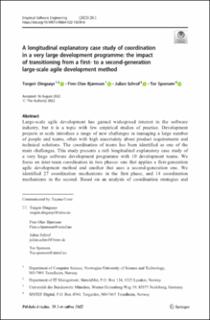| dc.contributor.author | Dingsøyr, Torgeir | |
| dc.contributor.author | Bjørnson, Finn Olav | |
| dc.contributor.author | Schrof, Julian | |
| dc.contributor.author | Sporsem, Tor Thorsrud | |
| dc.date.accessioned | 2023-02-27T16:58:20Z | |
| dc.date.available | 2023-02-27T16:58:20Z | |
| dc.date.created | 2022-08-17T09:18:17Z | |
| dc.date.issued | 2023 | |
| dc.identifier.citation | Empirical Software Engineering. 2023, 28, 1. | en_US |
| dc.identifier.issn | 1382-3256 | |
| dc.identifier.uri | https://hdl.handle.net/11250/3054421 | |
| dc.description.abstract | Large-scale agile development has gained widespread interest in the software industry, but it is a topic with few empirical studies of practice. Development projects at scale introduce a range of new challenges in managing a large number of people and teams, often with high uncertainty about product requirements and technical solutions. The coordination of teams has been identified as one of the main challenges. This study presents a rich longitudinal explanatory case study of a very large software development programme with 10 development teams. We focus on inter-team coordination in two phases: one that applies a first-generation agile development method and another that uses a second-generation one. We identified 27 coordination mechanisms in the first phase, and 14 coordination mechanisms in the second. Based on an analysis of coordination strategies and mechanisms, we develop five propositions on how the transition from a first- to a second-generation method impacts coordination. These propositions have implications for theory and practice. | en_US |
| dc.language.iso | eng | en_US |
| dc.publisher | Springer | en_US |
| dc.relation.uri | https://doi.org/10.1007/s10664-022-10230-6 | |
| dc.rights | Navngivelse 4.0 Internasjonal | * |
| dc.rights.uri | http://creativecommons.org/licenses/by/4.0/deed.no | * |
| dc.title | A longitudinal explanatory case study of coordination in a very large development programme: The impact of transitioning from a first- to a second-generation large-scale agile development method | en_US |
| dc.title.alternative | A longitudinal explanatory case study of coordination in a very large development programme: The impact of transitioning from a first- to a second-generation large-scale agile development method | en_US |
| dc.type | Peer reviewed | en_US |
| dc.type | Journal article | en_US |
| dc.description.version | publishedVersion | en_US |
| dc.rights.holder | © The Author(s) 2022. | en_US |
| dc.source.pagenumber | 49 | en_US |
| dc.source.volume | 28 | en_US |
| dc.source.journal | Empirical Software Engineering | en_US |
| dc.identifier.doi | 10.1007/s10664-022-10230-6 | |
| dc.identifier.cristin | 2043681 | |
| dc.relation.project | Norges forskningsråd: 236759 | en_US |
| dc.source.articlenumber | 2 | en_US |
| cristin.ispublished | false | |
| cristin.fulltext | original | |
| cristin.qualitycode | 2 | |

